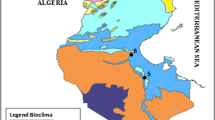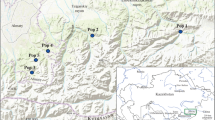Abstract
Pinus is the largest genus of conifers, containing over 100 species and is also the most widespread genus in the Northern Hemisphere. Pinus monticola and P. strobus are two closely related and economically important species in Canada. Morphological and allometric characteristics have been used to assess genetic variation within these two species but these markers are not reliable due to ecological variations. The purpose of the present study was to determine the level of genetic diversity within and among Canadian populations from the two species using molecular markers and to identify and characterize genome-specific inter-simple sequence repeats (ISSR) and random amplified polymorphic DNA (RAPD) markers. The level of genetic variation among populations was much lower for P. monticola than P. strobus. For both species, the among population variation values were smaller than within population variation. The populations from P. monticola were more closely genetically related than populations from P. strobus based on ISSR and RAPD analyses. Six ISSR and four RAPD markers specific to either P. monticola or P. strobus were cloned and sequenced. Primer pairs flanking these specific sequences were designed and genome specific SCAR markers for P. monticola and P. strobus were developed and characterized.
Similar content being viewed by others
References
Armstrong J. S., Gibbs A. J., Peakall R., Weiller G. (1994) The RAPDistance Package. 2005.
Barnes B. V. (1967) Phenotypic variation associated with elevation in western white pine. Forest Sci. 13: 14, 357–364.
Beaulieu J. and Simon J. P. (1994). Genetic structure and variability in Pinus strobus in Québec. Canad. J. For. Res. 24: 1726–1733
Brown A. H. D. (1979). Enzyme polymorphism in plant populations. Theor. Population Biol. 15: 1–42
Buchert G. P. (1994). Genetics of white pine and implications for management and conservation. The Forestry Chronicle 70: 427–434
DeVerno L. L. and Mosseler A. (1997). Genetic variation in red pine (Pinus resinosa) revealed by RAPD and RAPD-RFLP analysis. Canad. J. For. Res 27: 1316–1320
Echt C. S., MayMarquardt P., Hseih M. and Zahorchak R. (1996). Characterization of microsatellite markers in eastern white pine. Genome 39: 1102–1108
Echt C. S. and Nelson C. D. (1997). Linkage mapping and genome length in eastern white pine (Pinus strobus L.). Theor. Appl. Genet. 94: 1031–1037
Eckert R. T., Joly R. J. and Neale D. B. (1981). Genetics of isozyme variants and linkage relationships among allozyme loci in 35 eastern white pine clones. Canad. J. For. Res. 11: 573–579
Flint R. F. (1945) Glacial map of North America. Spec. Pap. Geol. Soc. Am. No. 60.
Fang D. Q. and Roose M. L. (1997). Identification of closely related citrus cultivars with inter-simple sequence repeat markers. Theor. Appl. Genet. 95: 408–417
Gernandt D. S., Lopez G. G., Garcia S. O. and Liston A. (2005). Phylogeny and classification of Pinus. Taxon 54: 29–42
Grotkopp E., Rejmanek M., Sanderson M. J. and Rost T. L. (2004). Evolution of genome size in pines (Pinus) and its life-history correlates: Supertree analyses. Evolution 58: 1705–1729
Jain T. B., Graham R. T. and Morgan P. (2004). Western white pine growth relative to forest openings. Canad. J. For. Res. 34: 2187
Kim M. S., Brunsfeld S. J., McDonald G. I. and Klopfenstein E. (2003). Effect of white pine blister rust (Cronartium ribicola) and rust-resistance breeding on genetic variation in western white pine (Pinus monticola). Theor. Appl. Genet. 106: 1004–1010
Mantel M. (1967). The detection of disease clustering and a generalized regression approach. Cancer Res. 27: 209–220
Nagaoka T. and Ogihara Y. E. (1997). Applicability of inter-simple sequence repeat polymorphisms in wheat for use as DNA markers in comparison to RFLP and RAPD markers. Theor. Appl. Genet. 94: 597–602
Nkongolo K. K., Michael P. and Demers T. (2005). Application of ISSR, RAPD, and cytological markers to the certification of Picea mariana, P. glauca, and P. engelmannii trees, and their putative hybrids. Genome 48: 302–311
Nkongolo K. K., Michael P. and Gratton W. S. (2002). Identification and characterization of RAPD markers inferring genetic relationships among Pine species. Genome 45: 51–58
Nkongolo K. K. (1999). RAPD and cytological analyses of Picea spp. from different provenances: Genomic relationships among taxa. Hereditas 130: 137–144
Nkongolo K. K., Deverno L. and Michael P. (2003). Genetic validation and characterization of RAPD markers differentiating black and red spruces: molecular certification of spruce trees and hybrids. Pl. Syst. Evol. 236: 151–163
Qian W., Ge S. and Hong D. Y. (2001). Genetic variation within and among populations of a wild rice Oryza granulata from China detected by RAPD and ISSR markers. Theor. Appl. Genet. 102: 440–449
Quinby P. A. (2000) An overview of the conservation of old-growth red and eastern white pine forest in Ontario. Report No. 23, Ancient Forest Research Report.
Raina S. N., Rani V., Kojima T. and Ogihara Y. (2001). RAPD and ISSR fingerprints as useful genetic markers for analyis of genetic diversity, varietal identification, and phylogenetic relationships in peanut (Arachis hypogaea) cultivars and wild species. Genome 44: 763–772
Rajora O. P., DeVerno L., Mosseler A. and Innes D. J. (1998). Genetic diversity and population structure of disjunct Newfoundland and central Ontario populations of eastern white pine. Canad. J. Bot. 76: 500
Rehfeldt G. E. (1979). Ecotypic differentiation in populations of Pinus monticola in North Idaho- Myth or reality?. Amer. Naturalist 114: 627–636
Rehfeldt G. E., Hoff R. J. and Steinhoff R. J. (1984). Geographic patterns of genetic variation in Pinus monticola. Bot. Gaz. 145: 229–239
Rus-Kortekaas W., Smulders M. J. M., Arens P., Vosman B. (1994) Direct comparison of levels of genetic variation in tomato detected by a GACAcontaining microsatellite probe and by random amplified polymorphic DNA. Genome: 375–381.
Ryu J. B. (1982) Genetic structure of Pinus strobus L. based on foliar isozymes from 27 provenances. Ph.D., University of New Hampshire, Durham.
Saitou N., Nei M. (1987) The neighbor-joining method:A new method for reconstructing phylogenetic trees. Molec. Biol. Evol. pp. 406–425.
Sambrook J., Fritsch E. F. and Maniatis T. (1989). Molecular cloning: a laboratory manual. 2nd edn. Cold Springs Harbor Laboratory, Long Island, New York
Sanchez de la Hoz M. P. S., Davila J. A., Loarce Y. and Ferrer E. (1996). Simple sequence repeat primers used in polymerase chain reaction amplifications to study genetic diversity in barley. Genome 39: 112–117
Steinhoff R. J., Joyce D. G. and Fins L. (1983). Isozyme variation in Pinus monticola. Canad. J. For. Res. 13: 1122–1132
Syring J., Willyard A., Cronn R. and Liston A. (2005). Evolutionary relationships among Pinus (Pinaceae) subsections inferred from multiple low-copy nuclear loci. Amer. J. Bot. 92: 2086–2100
Vidakovic M. (1991) Conifers morphology and variation, Translated from Croatian by Maja Soljan. Croatia, Graficki Zavod Hrvastske.
Williams J. G. K., Kubelik A. R., Livak K. J., Rafalski J. A. and Tingey S. V. (1990). DNA polymorphism amplified by arbitrary primers are useful as genetic markers. Nucl. Acids Res. 18: 6531–6535
Author information
Authors and Affiliations
Corresponding author
Rights and permissions
About this article
Cite this article
Mehes, M., Nkongolo, K. & Michael, P. Genetic analysis of Pinus strobus and Pinus monticola populations from Canada using ISSR and RAPD markers: development of genome-specific SCAR markers. Plant Syst. Evol. 267, 47–63 (2007). https://doi.org/10.1007/s00606-007-0534-1
Received:
Accepted:
Published:
Issue Date:
DOI: https://doi.org/10.1007/s00606-007-0534-1




